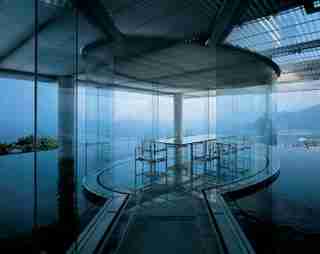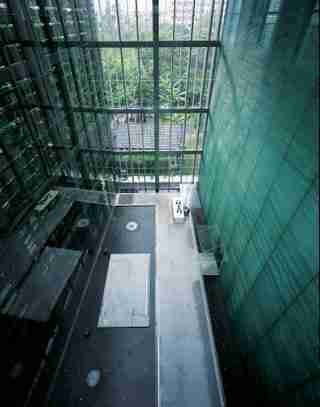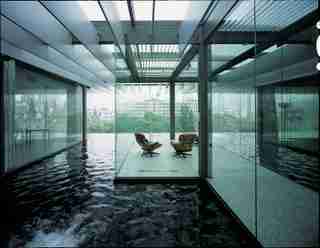For nearly 30 years, Kengo Kuma has been a leading talent in contemporary architecture. His work, which reinterprets traditional elements of Japanese architecture and showcases natural materials, was collected in Kengo Kuma: Complete Works (Thames & Hudson, $75). Now a second edition of the volume, which contains five new projects, is being published to coincide with the opening of his latest building, the Victoria & Albert Museum in Dundee, Scotland. “The architecture of V&A Dundee is the embodiment of a dialogue between the earth and the river of Scotland,” says Kuma. The book is groups the projects by materials—water-glass, wood-grass-bamboo, and stone-earth-ceramic. “I believe that the 21st century will be an era of the material,” he says. “Because concrete and steel dominated the 20th century, human beings were deprived of opportunities to communicate with materials.” Read on to see some of the spectacular buildings featured in the new edition.

Kuma’s Water/Glass, a guesthouse in Atami, Shizuoka, Japan, was completed in 1995. The structure was designed to feel connected to the sea and pays homage to German architect Bruno Taut, whose only project in Japan is located nearby.

Z58 is an office and showroom designed for a lighting company in Shanghai. Completed in 2006, the project involved the renovation of a four-story factory building. The exterior is lined with stainless-steel planters and Kuma installed a waterfall over ribbed glass inside.

Water was incorporated into the entire design of the building. A seating area in the penthouse of Z58 overlooks the pool and is topped with aluminum louvers.
Set outside New Canaan, Connecticut, is Glass/Wood, a private residence completed in 2010. Kuma designed an addition to a home built by architect Joe Black Lee and used an L-shaped plan to create a sense of intimacy within the site.
Kuma took inspiration from the woodblock prints of Ando Hiroshige for the Nakagawa-machi Bato Hiroshige Museum, which is devoted to the artist’s work. Cedar louvres line the exterior, referencing the way the Hiroshige depicts rain.
Completed in 2006, the Yusuhara Town Hall was built using wood to celebrate the region’s forestry industry. The central atrium was designed as a town square with a bank, service windows, an agricultural cooperative, and a movable stage for kagura performances.
For the GC Prostho Museum, Kuma used a joint system called Chidori, which is traditionally used in wooden toys. The 3-D lattice is made of wooden sticks that are oriented in three directions and joined together without nails or adhesive. Inside, the lattice is used as display cases for the museum’s collection.
Lotus House is a villa set in a forest in Eastern Japan. Kuma integrated a lotus pond into the design to connect the home, the river at the front of the house, and the forest behind it. Suspended travertine panels create a checkerboard pattern on the exterior.
Kuma designed the Museum of Wisdom in Chengdu, China, as a continuous form reaching toward the sky. Curved tiles, which are traditionally used as roofing materials in the area, were hung from stainless-steel wires to form screens along the exterior.
The second edition of Kengo Kuma: Complete Works will be released on October 9. A glimpse of the new V&A Dundee, which opens on September 15, graces the cover.
